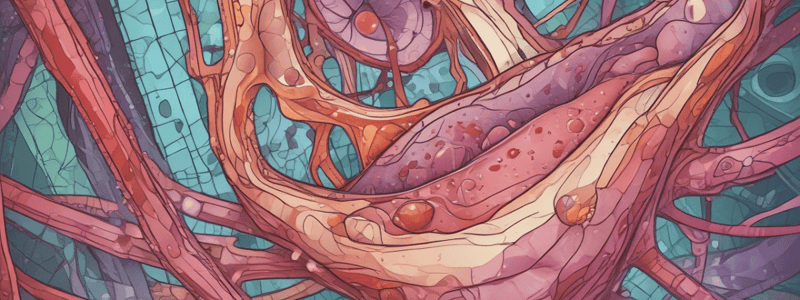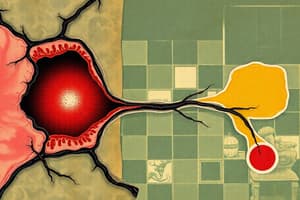Podcast
Questions and Answers
What is the primary difference between regeneration and repair in healing of damaged tissue?
What is the primary difference between regeneration and repair in healing of damaged tissue?
- Regeneration restores normal function, while repair results in loss of specialized function (correct)
- Regeneration is a response to minor injuries, while repair is a response to major injuries
- Regeneration is a faster process, while repair is slower
- Regeneration is a response to external injuries, while repair is a response to internal injuries
What is the primary cause of tissue injury?
What is the primary cause of tissue injury?
- Traumatic events, such as car accidents (correct)
- Disease, such as ulcers or carcinomas
- Aging
- Surgery
What is the purpose of the haemostasis stage in wound healing?
What is the purpose of the haemostasis stage in wound healing?
- To promote proliferation of stem cells
- To seal the wound with a clot or scab (correct)
- To stimulate inflammation
- To repair damaged tissue
What is the result of incomplete regeneration?
What is the result of incomplete regeneration?
What is the primary function of cytokines in the inflammation stage of wound healing?
What is the primary function of cytokines in the inflammation stage of wound healing?
What is the outcome of the proliferation stage in wound healing?
What is the outcome of the proliferation stage in wound healing?
What is the primary function of neutrophils, macrophages, and lymphocytes during the wound healing process?
What is the primary function of neutrophils, macrophages, and lymphocytes during the wound healing process?
What is the main component of granulation tissue responsible for its granular appearance and texture?
What is the main component of granulation tissue responsible for its granular appearance and texture?
What is the primary function of fibroblasts and myofibroblasts during the wound healing process?
What is the primary function of fibroblasts and myofibroblasts during the wound healing process?
What is the term for the abnormal scar forming as a result of fibrous repair?
What is the term for the abnormal scar forming as a result of fibrous repair?
What is the primary difference between regeneration and fibrous repair?
What is the primary difference between regeneration and fibrous repair?
What is the term for the formation of new blood vessels during the wound healing process?
What is the term for the formation of new blood vessels during the wound healing process?
What is the primary function of endothelial cells and progenitor cells during the wound healing process?
What is the primary function of endothelial cells and progenitor cells during the wound healing process?
What is the term for the process of healing of bone fractures?
What is the term for the process of healing of bone fractures?
What is the primary function of cytokines during the bone healing process?
What is the primary function of cytokines during the bone healing process?
What is the characteristic of bone formed during the hard callus stage?
What is the characteristic of bone formed during the hard callus stage?
What is the primary difference between primary and secondary intention healing?
What is the primary difference between primary and secondary intention healing?
What is the result of tertiary intention healing?
What is the result of tertiary intention healing?
What is the primary consequence of abnormal nerve regeneration during the healing process?
What is the primary consequence of abnormal nerve regeneration during the healing process?
What is the characteristic of bone that is not physically stressed during the remodelling process?
What is the characteristic of bone that is not physically stressed during the remodelling process?
What is the primary function of osteoprogenitor cells during the bone healing process?
What is the primary function of osteoprogenitor cells during the bone healing process?
What is the characteristic of the soft callus stage during the bone healing process?
What is the characteristic of the soft callus stage during the bone healing process?
Flashcards are hidden until you start studying
Study Notes
Regeneration and Repair
- Regeneration is the growth of cells and tissues to replace lost structures, resulting in complete restoration of normal function and no scar.
- Repair is the process of replacing severely damaged or non-regenerative tissues with connective tissue (scar), resulting in loss of specialized function.
Wound and Tissue Injury
- A wound is an injury to the skin with or without underlying tissues or organs, caused by surgery, trauma, heat, cold, chemicals, or disease.
- Tissue injury can occur in any organ or tissue, caused by traumatic events, ischemia, internal bleeding, sprains, or aging.
Processes and Timing of Wound Healing
- There are four stages of wound healing: haemostasis, inflammation, proliferation, and remodelling.
- Haemostasis involves clotting and scab formation to seal the wound.
- Inflammation involves the production of cytokines and phagocytosis to clean the wound.
- Proliferation involves the regrowth of structures by stem cells.
- Remodelling involves the functional recovery of the wound, with the scar disappearing and regeneration complete.
Cell Types Involved in Healing
- Inflammatory cells (neutrophils, macrophages, lymphocytes) phagocytose debris and produce chemical mediators.
- Endothelial cells and progenitor cells proliferate and undergo angiogenesis.
- Fibroblasts and myofibroblasts produce collagen and contract.
- Parenchymal cells (skin epithelial cells) proliferate and restore skin structure.
Granulation Tissue
- Granulation tissue is a type of repair tissue that has a granular appearance and texture.
- It consists of endothelial cells and capillaries, fibroblasts and myofibroblasts, type I collagen, and chronic inflammatory cells.
- Granulation tissue fills the gap, promotes angiogenesis, contracts, and closes the wound.
Fibroblasts and Myofibroblasts
- Fibroblasts and myofibroblasts produce type I collagen and contract to close the wound.
Fibrous Repair and Scar
- Fibrous repair is a scar formed by fibrovascular connective tissue that replaces lost tissue after an injury.
- It occurs when there is extensive tissue loss or local infection, and is associated with loss of function.
- Scarring is a natural part of the healing process, and goes through the same four stages as wound healing.
Complications of Fibrous Repair
- Complications include keloid formation, loss of function, and abnormal scarring.
Dynamic Process of Regeneration and Fibrous Repair
- Regeneration and fibrous repair occur simultaneously, with varying combinations of both processes.
- Beneficial aspects of fibrous repair include closing the wound and stopping further damage.
Regeneration and Repair in Other Organs and Tissues
- Healing of bone fractures involves similar processes as other tissues, with some modifications for the special environment and structure of bone.
- Healing of bone fractures involves haematoma formation, inflammation, granulation tissue, soft callus, hard callus, and lamellar bone formation.
Clinical Classification
- Healing by primary intention occurs when wound surfaces are closed, with little tissue loss and no infection, resulting in regeneration.
- Healing by secondary intention occurs when there is extensive tissue loss or infection, resulting in fibrous repair.
- Healing by tertiary intention is a type of wound healing that is also known as "delayed" or "secondary closure".
Factors Influencing Regeneration and Repair
- Factors influencing regeneration and repair include various factors, such as growth factors, hormones, and oxygen supply.
Peripheral Nerve Regeneration and Repair
- Peripheral nerve regeneration and repair involve the growth of nerve tissue and the restoration of nerve function.
Consequences of Healing
- Traumatic neuroma is a benign growth of nerve tissue that occurs in response to injury or surgery, resulting in pain and abnormal sensation.
Studying That Suits You
Use AI to generate personalized quizzes and flashcards to suit your learning preferences.




